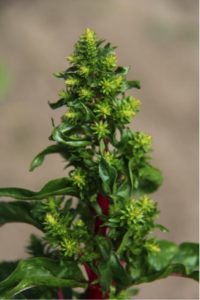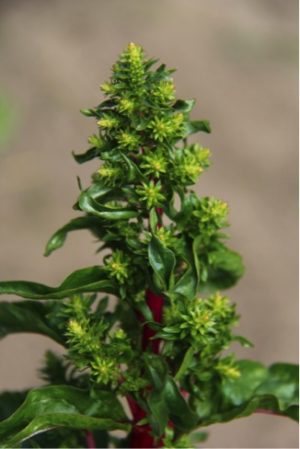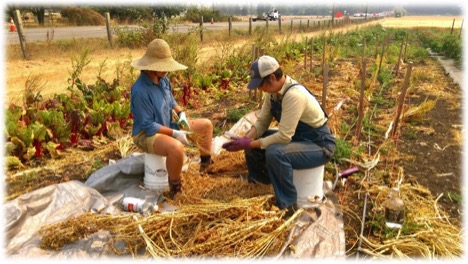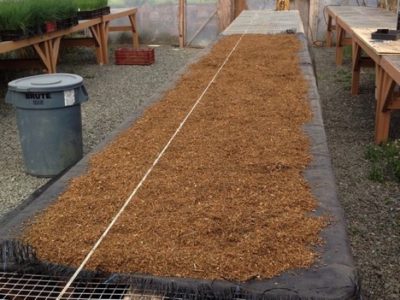Beet Seed Production: Quick Reference - Organic Seed Alliance

Beet Seed Production
Beets are a biennial crop, so seed production must take into account a two-year reproductive cycle.
Year 1: Producing the beet
Beets prefer relatively dry climates with cool to moderate summer temperatures. They need sandy or silty loam soils with good micronutrient balance since they are susceptible to boron deficiency. Beets should be direct seeded or transplanted in early to mid-summer and thinned to four plants per foot. If selecting for color, transplant seedlings rather than direct seeding as it allows for a much easier rogueing of undesirable color when multiple plants sprout from a single seed. Seed only one seed per cell in the tray. With direct seeding identifying multiple plants growing from the same seed is difficult, thus making selection more challenging and potentially less effective. Selection should be based on healthy tops and roots that are true-to-type and disease-free. Similar to onion and carrot, 120-200 plants are needed to produce seed and maintain the genetic health of the population. Harvesting of the roots is easiest when the soil is moist, but not saturated, so that soil can be wiped off by hand for visual evaluation. Do not wash roots or rub with a stiff brush. Tops should be trimmed to ½ inch above the crown without removing the apical bud. The taproot can also be trimmed to 2.5-3 inches. Then they can be stored at 34-38°F with 90-95%RH.
Year 2: Producing the beet seed
Beets are highly outcrossing and wind pollinated so need to be isolated from other beet and Swiss chard varieties by 1-3 miles depending on physical obstructions and wind conditions. When planted for seed, clay soils are best and seed set is best at relatively cool temperatures, between 60-75°F is ideal. Beets need moderate fertility and prefer a slightly acidic soil. They are also tolerant of high salt content. Any diseased or rotten roots should be discarded and not planted for seed production. Disease can be minimized by avoiding overhead watering. Plant the beets 2 feet apart in rows that are 3 feet apart. Seed may take between 140-160 days to mature, so planning for this long season is paramount. Seed formation will begin 6-10 weeks after flower stalk initiation and mature seed may take another several weeks.

Harvesting can begin when approximately 75% of the seed is brown and fully mature. On a small scale the seed stalks can be cut by hand. Then the stalks are stripped of seed (this can be done by hand – it is advisable to wear leather gloves), or threshed by walking or driving on a pile or windrow of plants.

It works well to do an initial pass through large gauge screen such as a half-inch mesh hardware cloth screen to remove large sticks, chaff and debris after threshing. Spread this rough-scalped seed out on landscape cloth (or other breathable cloth) in a drying shed or hoop house for a few days to a couple weeks (weather and location dependent) to complete the drying before any further seed is processed.

Cleaning beet seed can be a dusty process so it is wise to wear a respirator. Threshing the seed by foot will help eliminate some of the corky outer seed coat. Scalping screens discard much of the remaining sticks, and sieve screens get rid of small beet seed and tiny bits of debris. Winnowing with a box fan helps to eliminate the light dust and chaff. A few sticks usually remain at this stage of cleaning. For small seed lots these sticks can be picked out by hand. Larger lots can be run across an inclined draper, which has an adjustable, moving belt with a textured surface that retains the sticks and allows the beet seed to roll away into a separate container. Seed can be stored for 2-5 years when dried to 7.5%, or less, moisture and stored under favorable conditions of 40-60°F and less than 40%RH.
Selection and Variety Improvement
As with carrots, selections for foliar traits, root characteristics (such as external and internal color(s), shape, size, skin smoothness, flavor) and resistance to disease and bolting should be made in year one when roots are fully mature. Plan to make selections during and after storage as well, selecting roots that have maintained quality, have not grown excessive root hairs, and have not succumbed to disease or rot while in storage. Always discard and never replant any diseased or rotten roots.
| Trait | Timing |
| Seedling vigor | 2-3 weeks after seedling emergence |
| Leaf size, shape, color | Before or at root harvest |
| Leaf quality | Before or at root harvest |
| Root shape | Before or at root harvest |
| Root and crown smoothness | Before or at root harvest |
| Root color (exterior & interior) | After root harvest (exterior) and just before re-planting stored roots (interior) |
| Root uniformity | At or after root harvest |
| Disease resistance | Throughout season |
| Insect resistance | Throughout season |
| % Marketable roots | At or after root harvest |
| Marketable yield (whole plot & weight per root) | At or after root harvest |
| Storagability | Periodically throughout winter, 2-8 months after harvest |
| Flavor – raw | At harvest, and periodically for the next several months |
Disease
Use disease-free seed. Grow beets in well-drained soil with good air circulation between plants. Utilize 3-5 year crop rotations. Avoid injury to roots during storage. Diseases are classified by severity with a class of 1 being the most severe and 3 the least severe.
| Disease | Type | Severity class | Favorable conditions | Control measures |
| Phoma/Canker (Phoma betae) | Seedborne | 2 | Wet weather and warm soils | Good crop rotation; avoid injury to roots upon storage to reduce infection; for seed a hot water treatment (20 min. at 125°F) |
| Downy mildew (Peronospora farinosa f. sp. Betae) | Seedborne | 2 | High humidity and cool (45-60°F) daytime temperatures | Increased air flow by reducing plant population; avoid excess soil nitrogen; for seed a hot water treatment (20 min. at 125°F) |
| Bacterial leaf Spot (Pseudomonas syringae pv. aptata) | Seedborne | 2 | ||
| Cercospera leaf spot (Cercospera beticola) | Seedborne | 2 | Relative humidity exceeds 90%, often near windbreaks; nightime temperatures above 60°F and daytime temperatures above 80°F | Longer rotations (2-5 years) between Amaranthaceae crops; fields with good air circulation; reduced plant populations; plant resistant varieties; for seed a hot water treatment (20 min. at 125°F) |
| Fusarium wilt (Fusarium oxysporum f. sp. Betae) | Seedborne | 3 | >80°F temperatures and plants under stress | Good crop rotations; plant when soil temperatures don’t exceed 60°F ; plant in soils with good drainage; avoid burying plant crowns with soil. Plant resistant varieties. |
| Ramularia leaf spot (Ramularia betae) | Seedborne | 3 | ||
| Internal black spot | Root | |||
| Heart rot | Boron Deficiency | |||
| Rhizoctonia root & crown rot (Rhizoctonia solani) | Root | Wet soils | Good crop rotation; well-drained soils; avoid burying plant crowns with soil; plant resistant varieties | |
| Beet Leaf Miner (Pegomyla hyoscyami Panzer) | Insect | |||
| Webworms | Insect |
Also see Principles and Practices for Organic Beet Seed Production in the Pacific Northwest.
This resource was made possible thanks to the Montana Department of Agriculture’s Specialty Crop Block Grant Program.

